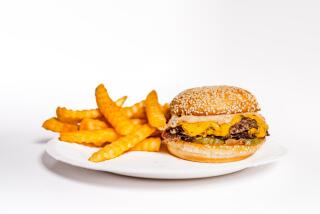Crabbing for Dollars
- Share via
While most of the food-buying public has been bemoaning the high prices of lettuce and vegetables, if you’re a crab-lover, this has been a spring to celebrate.
Dungeness crabs, the prime eating crab of the West Coast, has been selling at rock-bottom prices this year--as low as $2 to $3 a pound for live crab in Chinese markets. Prices are inching up now as supplies drop, but crab is still a great buy.
“Dungeness crab is one of the seafood bargains of the decade right now,” says Seafood Leader, a seafood industry magazine. “It can’t get any cheaper if the industry is to stay alive.”
Crabbing has always been a risky way to make a living as the market whipsaws up and down, seemingly at whim. Dungeness crabs are fished, not farmed, so the supply is determined by the vagaries of crustacean love. If there aren’t enough little crabs, prices go up.
Then too, the season cannot start until the molt (the shedding of the hard shell and replacement with another) is complete. This usually occurs around the first of December, with the harvest running heavy through the end of February before slowing down in the middle of March. This year, in fact, was a late-molting year, so we should have crab longer than usual.
In addition to Northern California, Dungeness crabs are taken in the deep ocean off Oregon, Washington state and British Columbia. There is also a small coastal fishery that runs year-round. It accounts for only about 25% of the total.
The average whole Dungeness crab weighs from 1 1/2 pounds to 3 1/2 pounds, about a quarter of that edible. Buy crabs that are active and full of fight. To cook a whole Dungeness crab, plunge into a large kettle full of rapidly boiling, salted water. Cook for 15 minutes, until shell turns pink and legs retract tightly under shell. Drain and rinse under cold water until cool enough to handle.
To clean, twist off legs and crack with a small mallet or nutcracker. Pull back the hard shell on top or carapace and remove gills and innards. Spoon out the “butter”--the green tomalley and reddish coral--and reserve to be added to mayonnaise for a dipping sauce, or simply to be eaten plain or spread on buttered bread. Dig out meat from inside of shell (the small end of an ice-tea spoon works great). Serve with crusty bread and a crisp, chilled Sauvignon Blanc.
More to Read
Sign up for The Wild
We’ll help you find the best places to hike, bike and run, as well as the perfect silent spots for meditation and yoga.
You may occasionally receive promotional content from the Los Angeles Times.







